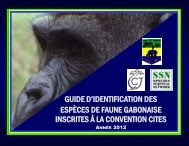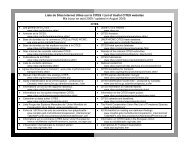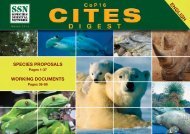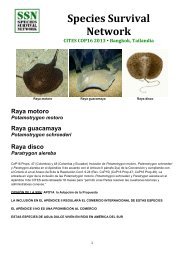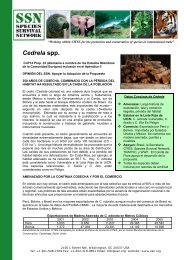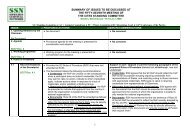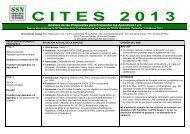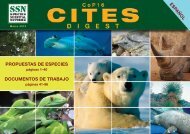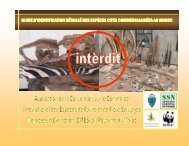SSN's Comments on South Africa's Regulations on Threatened and ...
SSN's Comments on South Africa's Regulations on Threatened and ...
SSN's Comments on South Africa's Regulations on Threatened and ...
You also want an ePaper? Increase the reach of your titles
YUMPU automatically turns print PDFs into web optimized ePapers that Google loves.
that the clause ‘means a listed animal that…’ be changed to ‘means an individual of a listed animal that<br />
has been dem<strong>on</strong>strated to be the cause of the alleged unreas<strong>on</strong>able damage’.<br />
Definiti<strong>on</strong>: Extensive wildlife system<br />
As noted above, the draft definiti<strong>on</strong>s of the key terms “c<strong>on</strong>trolled envir<strong>on</strong>ment” <strong>and</strong> “extensive wildlife<br />
system” significantly overlap <strong>and</strong> are indistinguishable. Both terms allow for food, water health care<br />
<strong>and</strong> fences. The definiti<strong>on</strong> of “c<strong>on</strong>trolled envir<strong>on</strong>ment” includes a means of enclosure to prevent the<br />
animals from escaping. While the definiti<strong>on</strong> of “extensive wildlife system” does not state whether or<br />
not there can be any sort of enclosure or attempt to keep the animals in the system, the definiti<strong>on</strong> of<br />
“c<strong>on</strong>trolled envir<strong>on</strong>ment” states that extensive wildlife systems can include fences. Although the<br />
definiti<strong>on</strong>s of these terms significantly overlap, animals bred <strong>and</strong> born in captivity in an “extensive<br />
wildlife system” would not be c<strong>on</strong>sidered “captive bred” under these definiti<strong>on</strong>s. These are key<br />
definiti<strong>on</strong>s because wildlife can be c<strong>on</strong>sidered “bred in captivity” <strong>on</strong>ly when produced in a “c<strong>on</strong>trolled<br />
envir<strong>on</strong>ment”, not an “extensive wildlife system”. This means that animals born into a captive setting<br />
in an extensive wildlife system can be hunted there or elsewhere. The intenti<strong>on</strong> seems to be to<br />
distinguish the terms based <strong>on</strong> the level of human interventi<strong>on</strong> (provisi<strong>on</strong> of food, etc.), the size of the<br />
l<strong>and</strong> involved, <strong>and</strong> the ability of the wildlife populati<strong>on</strong> to be “self-sustaining”. Yet, in practice, there<br />
would be a sliding scale of such operati<strong>on</strong>s <strong>and</strong> it would be difficult to judge where to draw the line<br />
based <strong>on</strong> these definiti<strong>on</strong>s. More importantly, if the objectives are to eliminate hunting of captive-bred<br />
animals <strong>and</strong> canned hunting, the draft should be revised to explicitly prohibit the hunting of animals<br />
captive-bred or c<strong>on</strong>fined within any enclosure. It is c<strong>on</strong>tradictory to claim that the desired effect is to<br />
ban canned hunting when the draft regulati<strong>on</strong>s allow the hunting of large carnivores within fenced<br />
areas. It is also c<strong>on</strong>tradictory to claim that large carnivores will not be captive bred for hunting when<br />
the draft regulati<strong>on</strong>s allow the hunting of animals bred in captivity, including <strong>on</strong> fenced extensive<br />
wildlife systems.<br />
Definiti<strong>on</strong>: Management plan<br />
The term “management plan” is not defined in secti<strong>on</strong> 1 of the Protected Areas Act as stated in the<br />
draft.[3]<br />
Definiti<strong>on</strong>: Put <strong>and</strong> take animal<br />
This is defined as “a live specimen of a listed large predator species that is released <strong>on</strong> a property<br />
irrespective of the size of the property for the purpose of hunting the animal.” We recommend that this<br />
term not be c<strong>on</strong>fined <strong>on</strong>ly to “listed large predator species” but to all “listed species”. There are no<br />
sound ethical or c<strong>on</strong>servati<strong>on</strong>-based reas<strong>on</strong>s that any threatened or protected species should be subject<br />
to “put <strong>and</strong> take”.<br />
Definiti<strong>on</strong>: Rehabilitati<strong>on</strong> facility<br />
Three key terms—“rehabilitati<strong>on</strong> facility”, “sanctuary”, <strong>and</strong> “captive breeding operati<strong>on</strong>”—need to be<br />
further distinguished from <strong>on</strong>e another. We recommend adding language to the definiti<strong>on</strong> of<br />
“rehabilitati<strong>on</strong> facility” that prohibits captive breeding, in order to distinguish such facilities from<br />
captive breeding operati<strong>on</strong>s. We further recommend adding language to the definiti<strong>on</strong> of “rehabilitati<strong>on</strong><br />
facility” that prohibits the l<strong>on</strong>g-term care of individuals at the facility, in order to distinguish such<br />
facilities from sanctuaries. Definiti<strong>on</strong> (b) allows keeping protected animals for “rearing purposes, in the<br />
case of young orphaned specimens”. We recommend clarifying this by adding the words, “… for<br />
release into the wild.” Otherwise, “rearing” could also mean “keeping” them permanently in captivity<br />
<strong>and</strong> providing life-time care, which should be the work of a sanctuary.<br />
4



